#fossilised ammonite shell
Explore tagged Tumblr posts
Photo

Bigotites thevenini Fossil Ammonite – Inferior Oolite, Jurassic Coast, Burton Bradstock, Dorset, UK
Presenting a rare and scientifically important Bigotites thevenini fossil ammonite from the famous Jurassic Coast near Burton Bradstock, Dorset, UK. This specimen originates from the renowned Inferior Oolite Formation, a key site for exceptional ammonite preservation.
Geological Unit: Inferior Oolite Formation
Geological Period: Jurassic
Stage: Bajocian (Middle Jurassic)
Depositional Environment: Shallow marine carbonate platform
Order: Ammonitida
Superfamily: Stephanoceratoidea
Family: Graphoceratidae
This impressive fossil was unearthed on 30 April 2025 by our dedicated field collectors, Alister and Alison. It was later cleaned, stabilised, and professionally prepared by Alison, ensuring its natural features and shell detail remain beautifully preserved. The piece remains in its original limestone matrix, offering superb visual and scientific appeal.
The photographs show the exact specimen you will receive, and a scale cube (1cm) is included for accurate size reference. For full dimensions, please consult the listing photos.
All of our Fossils are 100% Genuine Specimens & come with a Certificate of Authenticity.
A rare opportunity to own a genuine Bigotites thevenini ammonite—ideal for collectors, educators, or as a unique natural history display item.
#Bigotites thevenini#fossil ammonite Dorset#Jurassic ammonite UK#Inferior Oolite ammonite#Burton Bradstock fossil#Jurassic Coast fossil#authentic fossil ammonite#ammonite collector specimen#ammonite with certificate#paleontology gift#fossilised ammonite shell
0 notes
Text
Nautilus’ and Ammonites incredible ability to survive in low-oxygen climates (how some ammonite species survived the Permian extinction)
Some species of ammonites were able to survive the Permian Extinction (which killed around 90% of Earth’s species). How did they do this? Even the trilobites disappeared after their reign of about 300 million years! Well, why don’t I first explain what scientists hypothesize what might have caused the Permian Extinction. The pores of fossilised leaves suggest that carbon dioxide levels were high about 250 million years ago, following a colder period of time (the pores, or stomata, of leaves take in CO2 so fewer pores means more CO2 in the atmosphere and vice versa). A rapid and sudden drop in sea levels at the end of the Permian ruined shore and near-shore habitats which destabilized the climate. The death of the many inhabitants of those habitats cause mass decomposition. The process of decomposition causes carbon dioxide to be released which then causes a depletion of the available dissolved oxygen and global warming. Near the end of the Permian, there was also intense volcanic eruptions for a couple million years, causing an initial cold snap but then global warming and ozone depletion. The effect of these events cause the oceans to become incredibly anoxic, so most ocean creatures likely suffocated. Of course there are other possible occurrences that could have contributed to the mass extinction, but these are the main ones. Now, how did some ammonite species survive? Using nautilus’ scientists discovered that their shell can function like a Scuba tank. Nautilus’ can counter low oxygen environments by slowing down and lowering its chemical activity. The nautilus can also collect oxygen in its buoyancy chambers in which they then use the stored oxygen to breathe. Fossil evidence suggests the ammonites also had the ability to do this.
Source: In The Blink of an Eye by Andrew Parker
Image by Peter A. Austen
Nautilus (left) and artists depiction of the extinct ammonite (right)

#ammonite#nautilus#nautiloid#extinction#evolution#evolutionary biology#permian#permian extinction#mass extinction#aquatic animals#ancient animals#extinct animals#extinct species#science#palaeontology#cool facts#fun facts#interesting facts#interesting#life science#science facts
4 notes
·
View notes
Text
What is an ammonite?
Ammonites were shelled cephalopods that died out about 66 million years ago. Fossils of them are found all around the world, sometimes in very large concentrations.
The often tightly wound shells of ammonites may be a familiar sight, but how much do you know about the animals that once lived inside?
What were ammonites?
Before we understood what they were, one of the explanations for ammonites was that they were coiled-up snakes that had been turned to stone, earning them the nickname 'snakestones'. But ammonites weren't reptiles: they were ocean-dwelling molluscs, specifically cephalopods.

An ammonite fossil with a carved snake's head
Zoë Hughes, Curator of Fossil Invertebrates at the Museum, explains, 'Ammonites are extinct shelled cephalopods. All of them had a chambered shell that they used for buoyancy.'
The group Cephalopoda is divided into three subgroups: coleoids (including squids, octopuses and cuttlefishes), nautiloids (the nautiluses) and ammonites.
Ammonites' shells make the animals look most like nautiluses, but they are actually thought to be more closely related to coleoids.
'Some of their morphology was closer to that of the coleoid group,' says Zoë. 'We think it’s more likely that ammonites would have had eight arms rather than lots of tentacles like a nautilus, though the shell is more similar to that of a nautilus.'
Ammonites were born with tiny shells and, as they grew, they built new chambers onto it. They would move their entire body into a new chamber and seal off their old and now too-small living quarters with walls known as septa.

Ammonites looked a bit like nautiluses but are thought to be more closely related to coleoids, a group that includes octopuses and cuttlefish © Esteban De Armas/Shutterstock
Zoë adds, 'The ammonite would have lived in one chamber, but we don't know how often they built a new one.
'Previously it has been suggested this could have been a monthly occurrence, but there is no evidence for that. Some studies looking at the chemical composition of the shells - a field called sclerochronology - are starting to gain some insight of how long ammonites might have lived.'
Ammonites' growing shells typically formed into a flat spiral, known as a planispiral, although a variety of shapes did evolve over time. Shells could be a loose spiral or tightly curled with whorls touching. They could be flat or helical. Some species would begin growing their shell in a tight spiral but straighten it out through later growth phases. There were also some more unusual shapes - the species Nipponites mirabilis, which is found in Japan, is exceptionally rare and looks a bit like a knot.
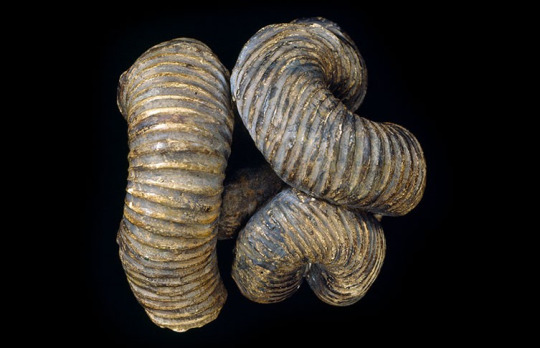
Nipponites mirabilis ammonites grew in an unusual knot shape, rather than in a typical spiral
While ammonite shells are abundant in the fossil record, it was only recently that scientists have found a very rare fossil of the soft parts of an ammonite. However, fossilised evidence of ammonite arms is yet to be found.
Until now, a lot of what we know about ammonites has been inferred based on what we see in living cephalopods.
How old are ammonites?
The subclass Ammonoidea, a group that is often referred to as ammonites, first appeared about 450 million years ago.
Ammonoidea includes a more exclusive group called Ammonitida, also known as the true ammonites. These animals are known from the Jurassic Period, from about 200 million years ago.
Most ammonites died out at the same time as the non-avian dinosaurs, at the end of the Cretaceous Period, 66 million years ago.
Zoë says, 'We didn't quite lose all of them at the end of the Cretaceous. A few species continued into the Palaeogene in the Western Interior Seaway before dying out.'

The astroid that hit Earth 66 million years ago and ended the age of dinosaurs is also thought to have been responsible for the demise of most ammonites. Image by Donald E Davis courtesy of NASA/JPL-Caltech, via Wikimedia Commons
Read more
Why did ammonites go extinct?
At the end of the Cretaceous Period, an asteroid colliding with Earth brought on a global mass extinction. A lingering impact winter halted photosynthesis on land and in the oceans, which had a major impact on food availability and was devastating for ammonites.
Nautiloids, however, which had ancient relatives that lived at the same time as ammonites, survived this mass extinction. It is thought this is in part linked to these groups' preferred water depths.
Zoë explains, 'Nautilus survived probably because it lives deeper in the ocean. Deeper environments were less affected by what was going on in shallow water environments. This is a pattern that can be seen in other groups, aside from cephalopods – fish, for example.
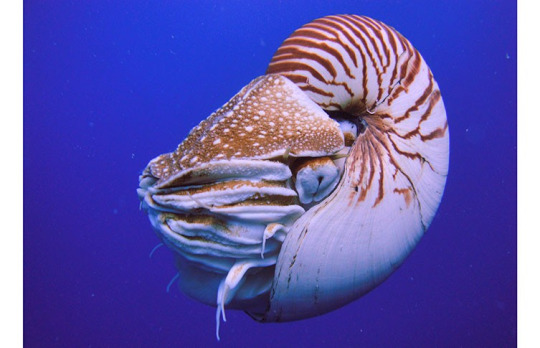
Ammonites mostly died out 66 million years ago, but other cephalopods, such as nautiluses, survived © Manuae via Wikimedia Commons (CC BY-SA 3.0)
The size of hatchlings may also have played in the nautiluses' favour as they were larger and would have been less restricted by the size of food available to them.
How many ammonite species were there?
Scientists can tell species of ammonites apart through several attributes including shell shape, size, age, location, features such as the number and spacing of ribs, defensive spines or shell-strengthening ornamentation.

We know this specimen of Kosmoceras phaeinum is a male from the long prongs, known as lappets, sticking out near the opening of the shell. They might have been used by the male to hold onto the female during mating, a bit like shark claspers.
Read more
But figuring out exactly how many species have been found so far is a bit tricky.
Like modern cephalopods, ammonites displayed sexual dimorphism, which is the noticeable difference in appearance between sexes. But when ammonite fossils that looked unique were found in the past, they tended to be recorded as new species instead of as the microconch (male) or macroconch (female) of an existing species, as this difference between the sexes was not yet known about.
However, it is estimated that over 10,000 species of ammonite - possibly even over 20,000- have been discovered.
Zoë says, 'Ammonites were quite diverse and evolved rapidly, so if you sample stratigraphically through rocks, you can actually see the evolution and the changes through them.'
How big were ammonites?
Ammonites came in a range of sizes, from just a few millimetres to times bigger, with larger sizes more common from the Late Jurassic onwards.
The largest known species of ammonite is Parapuzosia seppenradensis from the Late Cretaceous. The largest specimen found is 1.8 metres in diameter but is also incomplete. If it were complete, this ammonite's total diameter could have been from 2.5-3.5 metres.
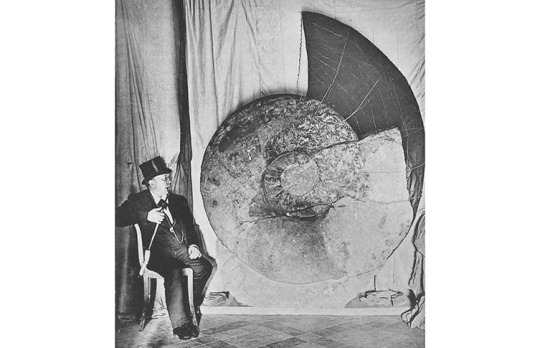
Parapuzosia seppenradensis is the largest known species of ammonite. Image via Wikimedia Commons
Where did ammonites live?
Ammonites lived all around the world. Like their modern-day cephalopod relations, they were exclusively ocean-dwelling. They tended to live in more shallow seas and may have had a maximum depth of about 400 metres.
What did ammonites eat and what ate them?
Though it would largely have depended on their size, ammonites would likely have eaten similar things to today's cephalopods, such as crustaceans, bivalves and fish. Smaller species would probably have eaten plankton. Some other species may have been scavengers, like living nautiloids can sometimes be.
Ammonites would also have served as food for other marine animals. There is evidence of mosasaurs and ichthyosaurs having eaten them, and some fish would likely also have considered them prey.

Ichthyosaurs were among the marine animals that would have preyed on ammonites
Why are ammonites important to science?
Ammonites can be a useful tool for scientists. Because they are so common and evolved so rapidly, they are excellent to help determine the age of the rocks they were fossilised in.
Much of the Mesozoic aged rock in Europe has been sectioned into 'ammonite zones', where rocks in different areas can be associated with each other based on the ammonite fossils found in them.
Zoë says, 'I've done a few identifications where there are bits of ichthyosaur and an ammonite has also been found, and they need it identifying. If you can identify the ammonite, you can really narrow things down. They're a really good indicator for biostratigraphy.'

Another potential use for ammonite fossils could be for telling us about how animals responded to climate change in the past.
Zoë explains, 'Shelled marine animals can help us look back into the past at what was going on in terms of climate change following extinction events. If we have known periods of warming or cooling, we can then infer that into modern climate science.
'Looking at size change will tell you an awful lot. Quite often after an extinction event a lot of shelled animals shrink because they don't have the resources they need to grow. If there isn't the resource to build their shells, it's a bit of a struggle for them. You see that in a lot of organisms.'
What is an ammonite? | Natural History Museum (nhm.ac.uk)
Ammonoidea
Animal
Ammonoids are extinct spiral shelled cephalopods comprising the subclass Ammonoidea. They are more closely related to living coleoids (i.e., octopuses, squid and cuttlefish) than they are to shelled nautiloids (such as the living Nautilus). The earliest ammonoids appeared during the Devonian, with the last species vanishing during or soon after the Cretaceous–Paleogene extinction event. They are often called ammonites, which is most frequently used for members of the order Ammonitida, which represented the only living group of ammonoids from the Jurassic onwards
Scientific name: Ammonoidea
Clade: Neocephalopoda
Domain: Eukaryota
Kingdom: Animalia
Phylum: Mollusca
Ammonoidea - Wikipedia
Is an ammonite fossil worth money?
Well, the largest ammonites with special characters can fetch a very high value above $1,000. Most of them are below $100 though and the commonest ammonites are very affordable. Some examples : an ammonite Acanthohoplites Nodosohoplites fossil from Russia will be found around $150.
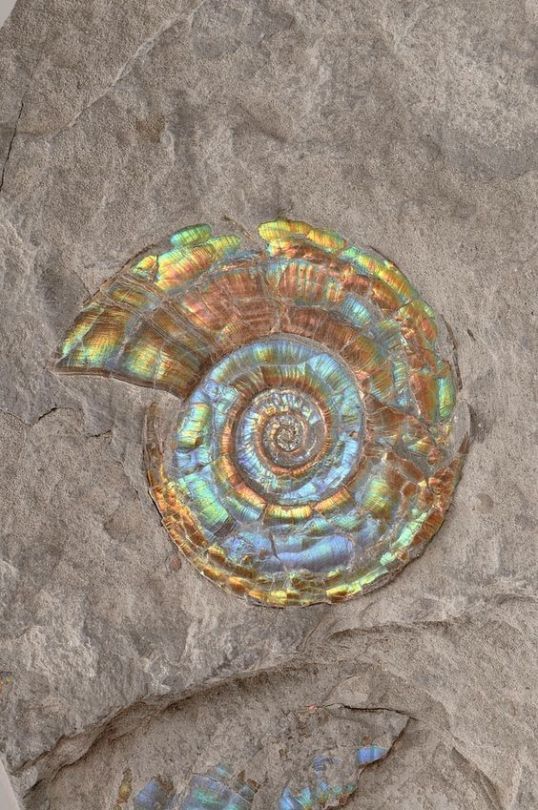
Ammonite fossil
6K notes
·
View notes
Text

Globidens Mososaur Tooth
The fossilised tooth of a Mososaur of the Globidens genus.
Mososaur from this genus had large, rounded teeth that were comparatively shorter than other types of Mososaur.
Globidens Mososaurs teeth were specialised for dealing with armoured prey, allowing them to crust the tough shells of prey such as turtles, ammonites, nautili and bivalves.
Globidens Mososaurs were of a relatively medium size as far as Mososaur go reaching around 5-6 metres in length.
They existed during the late Cretaceous period approximately 84.9 to 66 million years ago.
This tooth here was recovered from Morocco though fossils of this species have also been found in Angola, Brazil, Columbia, Syria and the USA.
1 note
·
View note
Photo




Iridescent Ammonite Canada
From the Upper Cretaceous, Bearpaw formation (75-72 million years ago), the 161⁄4-inch specimen of Placenticeras meeki displaying a dazzling iridescence of reds and oranges, greens and rich blues.
#iridescent ammonite#fossilised ammonite shells#fossil#gemstone#geology#geologist#ancient artifacts#history#history news#ancient history#pretty#beauty#beautiful
78 notes
·
View notes
Text
no 13
There is, in the middle of a bursting city, a piece of stone that was once bone, encased in glass. Number 13, says the audio guide. Fossilised ammonite. It was discovered underneath the foundations of the building it is now exhibited in, halting construction for weeks to come. The child presses their nose against the glass. It fogs up underneath their breath.
Once, longer ago than they can conceptualise, this mountain range was ocean floor. Once, when the earth was not new but younger, something died and sank to the bottom of its world. Like that, it lay there until all that was left was shell. Until, slowly, under salt water and darkness, the stone crept into the bone.
Once, a mosquito was caught in tree resin. It was stuck, see. It stayed there long after it had suffocated, see. Pressure makes diamonds. Pressure makes stone and cracks and imprints along the skin of this world. Time hardens tree resin until it doesn’t stick, anymore.
There are echoes of worlds long past burrowed deep into this soil. The earth has long since shifted, see. Long ago, something died on its surface and – something lived. Something sank and something rose and something crept into a cave it would never leave again.
Mama, says the child as the audio guide moves on to number 14, do you think the earth will remember us like this?
Their mother smiles. She pulls the child away from the glass, and draws her hands through their hair. Maybe, she says.
Together, they go into the next room to look at Lucy.
#writerblr#writebrl#fossil#natural history#on the way the earth remembers those who live in it#on the way we do#on connections across millennia#a visit to the natural history museum#and a contemplation of memory
96 notes
·
View notes
Photo










Fossil Hunting 2020
Same place I usually go to. Two days (back in September 2020), something like seven hours of walking, and some lovely finds.
The stratas represented where I was hunting were mostly of the Oxfordian stage (Jurassic). I wish I could identify everything here, but I’m just an amateur, so it’s a bit frustrating.
Urchins! I've never found any in that location before! The second one clearly fell from another strata and I'm not sure which one.
Various small shells, mostly brachiopods. Can identify goniorhynchia boueti, probably from a lower stage (bathonian?)
Myophorella
Various mussels
I'm sorry I'm terrible at identifying bivalves
Pecten
Lopha gregaria
Ammonites. That big one at the top is lovely
Ammonite fossilised in pyrite 1/2 and 2/2
That tiny pyrite ammonite might just be my coolest find ever, I screamed like a banshee when I saw it.
61 notes
·
View notes
Video
tumblr
yorkshire.fossils
On today’s hunt we came across this slab of shale with many fossils that had unfortunately worn away! 🌊🏝 Beneath the surface, around a hundred compressed fossilised shells were hiding! 🐚🐊 We also found a few lovely ammonites including a piece of wood with rare Pleuroceras ammonites fossilised alongside it!! For full fossil hunt episodes head to “Yorkshire.Fossils” on YouTube! I’ll upload some more videos when I can 🐊 There’s a link in my bio 🦕 If anyone would like a Genuine Yorkshire ammonite and support the page, message me!
#fossil#fossils#geology#paleontology#fossilfriday#ammonite#video#instagram#yorkshire#the earth story
163 notes
·
View notes
Text
Since soft tissues rot before they can fossilise and ammonites are commonly depicted with regular squid bodies sticking out of their shells, I like to think of ammonites as hulking cthulhoid giants with the shell like a party hat.
8 notes
·
View notes
Photo

8.5" Bredyia crassornata Ammonite Fossil – Inferior Oolite, Jurassic Coast, Burton Bradstock, Dorset UK – Genuine with COA
This exceptional 8.5" specimen of Bredyia crassornata is a striking ammonite fossil from the world-renowned Jurassic Coast, specifically collected from the Inferior Oolite strata at Burton Bradstock, Dorset, UK. It represents a fine example of Jurassic marine life and is an extraordinary addition to any fossil collection.
Bredyia crassornata is a large ammonite species notable for its robust, coarsely ribbed shell and strong ornamentation. The shell features thick radial ribs, a rounded whorl section, and a distinct zigzag suture pattern. This species is characteristic of the Middle Jurassic period, falling within the Aalenian stage.
Geological Details:
Species: Bredyia crassornata
Geological Formation: Inferior Oolite
Age: Middle Jurassic (Aalenian Stage)
Location: Burton Bradstock, Dorset, UK
Depositional Environment: Shallow marine shelf – oolitic limestone rich in ammonite fauna
Family: Graphoceratidae
Superfamily: Hildoceratoidea
Order: Ammonitida
This specimen was professionally discovered and excavated on the 17th of January 2025 by our dedicated team members, Alister and Alison. It has been meticulously cleaned, prepared, and stabilised by Alison to preserve its exceptional features.
Why Buy This Fossil?
100% genuine ammonite fossil
Sourced directly from the Jurassic Coast
Includes Certificate of Authenticity
Actual specimen photographed – what you see is what you get
Professionally prepared and preserved
Scale cube = 1cm for accurate sizing (please see photo)
Whether you're a collector, educator, or fossil enthusiast, this Bredyia crassornata ammonite makes a fascinating display and conversation piece.
All of our Fossils are 100% Genuine Specimens & come with a Certificate of Authenticity.
#Bredyia crassornata#ammonite fossil#Jurassic fossil#Inferior Oolite#fossil Dorset#Jurassic Coast fossil#Burton Bradstock ammonite#genuine ammonite#UK fossil#collectible fossil#fossil specimen#fossil shell#ammonite display#Jurassic ammonite#fossilised shell#ammonite UK
0 notes
Note
So nautiluses have a beak? Also, why does most paleoart depict ammonites with squid-like characteristics, rather than nautilus ones? Eg. Several large arms rather than dozens of tiny ones.
Yes, like all cephalopods nautiluses have beaks, they’re just harder to see due to the shell and the many tentacles. I couldn’t find a good picture of the beak of a real nautilus, but you can see it in this diagram.

Despite looking superficially similar to nautiluses, it is thought that the ammonite’s closest living relatives are actually the coleoid cephalopods - the squid, octopus, and cuttlefish. We think that the ammonite’s distinctive coiled shell evolved separately over time from their straight-shelled ancestors, bactrites.
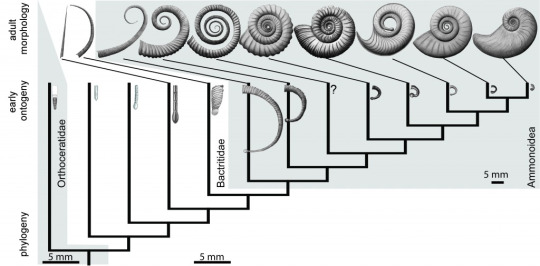
So while it is hard to be sure how many arms/tentacles ammonites had (since soft tissue doesn’t generally fossilise), I think a lot of palaeoartists depict them as being similar to modern coleoids in having around 10 arms/tentacles.
This episode of the Palaeocast podcast goes into ammonite evolution (I haven’t actually listened to the episode, but there is some good information/diagrams just on the page).
Also I’m sorry for taking ages to reply to this - I was busy for a while and then forgot that I still had unanswered questions to get to.
#anonymous#ask a mollusc#ammonite#ammonites#ammonoidea#nautilus#nautiluses#nautilida#cephalopod#cephalopods#cephalopoda#mollusc#mollusk#molluscs#mollusks#mollusca#evolution#evolutionary biology#anatomy#biology#nature#science#palaeontology#paleontology
156 notes
·
View notes
Text

Pyritized Ammonite
This is yet another fossilised ammonite (a prehistoric sea critter similar to todays nautilus)
This one has been sliced in half and polished to show the internal structure.
What’s happened with this Ammonite fossil is a process called permineralization which is the process of fossilisation tissues and bones in which minera deposits form an internal cast of specimens.
This process is particularly useful in the study of the internal structures of fossilised organisms as the minerals preserve that internal structure.
There’s a couple of different forms of permineralization such as:
Silification which involves the weathering of rocks releasing silicate minerals and result in an opaline look and as such may also be known as Opalization
Carbon mineralisation which creates ‘coal balls’
Pyritization which involves Sulfur and iron. This process occurs in specimens that end up in iron sulfide (pyrite) saturated marine sediments. This Pyrite replaces the carbonate materials that the shell of the animal (most often an ammonite or trilobite) is made from resulting in the internal structures of the specimen exhibiting this metallic golden pyrite. This same process can occurs with plants that are in clay rich terrain however it’s less commonly occurring than the above mentioned marine environment specimens.
1 note
·
View note
Text
D e s i g n i n g
Fossils


Here are some of my fossil designs. I put them together as a lot of them are the same just slightly different variations. I didn't do many fossil inspired designs as it wasn't a part of geology that really interested or inspired me. however i still wanted to create some designs on this part of geology.
For the first design shown in the clip i tried a different style of designing I used an image of an ammonite fossil and was just trimming the image to make it more rounded. Then i had the idea to use the scrap piece to create a turtle neck. I actually quite like this design and think the turtle neck merging into the shell could be a very interesting and innovative design.
My designs on the black shard shaped page are just different variations of an ammonite inspired design. I illustrated a baby doll style stop but with two shells with flowy fabric under neither them. I don't like this design and feel its quite boring and a very literal interpretation to fossils. However i liked the baby doll style and would maybe like to use this in my next designs.
For the other page I created a giant fossil as the background and i actually love this as the background. On top i stuck my turtle neck design i also created another design. For this design i wanted to try and experiment with detail on the back of a design. So i created a fossilised star fish cut out on the back of a black tank top. Even though the front of the design would have been quite basic i did like this cut out idea. So there was no need to illustrate the front as the focal point was the back.
0 notes
Photo
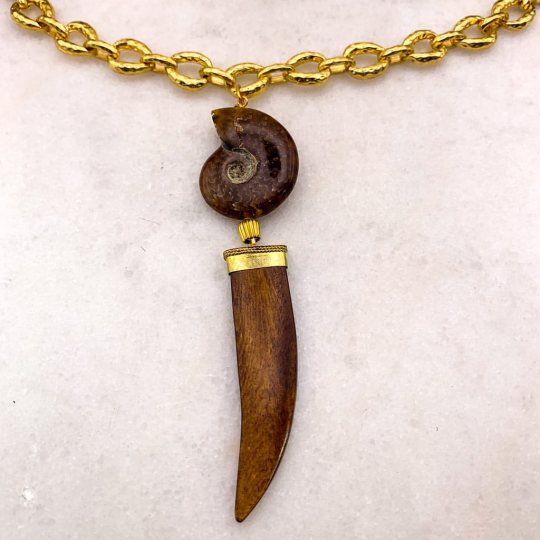
An incredible natural Ammonite Fossilised Gemstone. The Ammonite were shells of sea animals long extinct, that were once held to have healing and oracular powers. #handmadeinaustralia #ammonitefossil #talismanjewelry (at Bundjalung Nation) https://www.instagram.com/p/ClvPzZptryg/?igshid=NGJjMDIxMWI=
0 notes
Text
buckle up cos i got a bunch
first off let's start with the shrine

featuring the wørm guardians, a muntjac skull, pink sand, an amethyst (i think??), with a tooth and snail shell beside it, dried lavender, a lorge pinecone, a dragon statue based on the wawel dragon in Krakow, and my first wet specimen of a bee

then there's my rock, fossil and shell collection

featuring a feather from our barn owl Skye from college, before she unfortunately passed away :'(

a scorpion in resin (i forgot what species :') )

a fossilised tooth (??? i'm not sure)

four ammonites (one in a separate bag)

and some shark teeth (the big one i really want to make into a pendant)

then lastly i also have a bag of skulls i still need to clean

and a real rabbit's foot on my bag

Tumblr Show & Tell
I, father strange, will be hosting a tumblr show and tell. Please comment or reblog with a picture + explanation of your prized possessions that you would like to share with the class today. I expect to receive so many goblin jars, cursed pieces of Garfield merch, and questionably sourced bones.
Make sure you’re very comfortable with sharing because my favourites will be selected for a video!
#show and tell#strange aeons#goblin hoard#goblincore#vulture culture#crowcore#bone collecting#collection#animal skull#fossils#rocks#sea shells
5K notes
·
View notes
Text
The Perception of the Past
“how has scientific evidence affected the view on Tyrannosaurus Rex through popular media”
The Bad Beginnings

Our understanding of the way dinosaurs had looked like and behaved on earth sixty-six million years ago has evolved drastically over the many years of their discovery, for instance, in around 1852, when the first few dinosaur fossils, people had extraordinarily little clue on the appearance of the creatures they had found. They had assumed that due to how reptilian the fossils look, then the dinosaurs would have resembled giant and terrible lizards which is how they got their name (“dinosaur” means terrible lizard in Latin). This had been the norm for how dinosaurs had looked like for many years as scientists hadn’t made the appropriate discoveries, such as feather imprints in the stone indicating that dinosaurs had a very common ancestor of modern-day birds, or the complete skeleton of the dinosaurs the first of all correctly assume what the animals form looked like, but to also to discover that dinosaurs, which had obtained two hind legs for walking and had the diet of a carnivore (this group of dinosaurs had been given the name “therapods” meaning beast foot), had a more horizontal posture rather than a vertical posture; this would allow them to balance more equally while using there tail as a counter balance. The Crystal palace dinosaurs are a perfect example of how the Victorians believed dinosaurs appeared to look like, due to the fragmented fossils which were discovered; they believed that the shells, found from ancient mollusc by the name of ammonites, where the fossilised remains of the creature’s eye.
https://en.wikipedia.org/wiki/Crystal_Palace_Dinosaurs#/media/File:Mantellodon_in_Crystal_Palace_Park.jpg (image reference)
https://www.nhm.ac.uk/discover/crystal-palace-dinosaurs.html#:~:text=The%20Crystal%20Palace%20dinosaurs%20were,to%20the%20public%20in%201854. (Information reference)
The Progressive Imagery

Fast forward a few years later closer to modern day and more scientific discoveries are being unearthed regarding the classification of dinosaurs, one in particular in 1902 changed everything they had knew about the general form, shape and appearance of the mighty tyrannosaurus rex. In 1902 in the Hell creek formation located in Montana, a palaeontologist by the name of Hunter Barnum Brown had unearthed an almost complete skeleton of tyrannosaurus rex; and in 1905, a man by the name of Henry Fairfield Osborn who had discovered a second skeleton gave the extinct creature its very name. looking at the photograph, the palaeontologists who were working on the skeleton did do a decent job in putting the bones together, however, they had failed to acknowledge that the tyrannosaurus rex standing in that posture would be absolutely preposterous as the joints in the leg would have given out if it were to reach that far in the socket. The scientists and media had come to the conclusion that due to both how reptilian the creature had looked, and the previous ideologies of dinosaurs from the past, that tyrannosaurus was a very reptile like creature, up to the point to where early sketches of tyrannosaurus rex where that of upstanding iguanas with head too analogous to that of modern lizards. This idea of a vertical posture can be seen in early films depicting dinosaurs such as “Lost World (1925)” where the tyrannosaur stands almost human like in order to take down a plump triceratops.
https://www.amnh.org/exhibitions/permanent/saurischian-dinosaurs/tyrannosaurus-rex (image reference)
https://www.amnh.org/dinosaurs/tyrannosaurus-rex#:~:text=Henry%20Fairfield%20Osborn%2C%20then%20the,Museum's%20Cretaceous%20Hall%20in%201960. (Who named the t-rex)
https://www.youtube.com/watch?v=huoitHFVaBg (media influence)
The Best Movie Ever

Around 90 years later in 1993, a famous director by the name of steven Spielberg develop a new movie about the captivity and the reverse engineering of dinosaurs by the name of Jurassic Park. Not only dispelling common dinosaur myth such as the horizontal stance of the tyrannosaur; but Jurassic Park, with the aid of Stan Winston, had created a series of speculation about the long extinct animals which are still questioned today, for example, the inclusion of velociraptor displaying pack like behaviour, seen with the pack of the creatures lead by the alpha female of the group which was nicknamed “the big one” due to its enlarged size. Despite how popular and revolutionary Jurassic Park has been in shaping the view of dinosaurs such as tyrannosaurus rex, there are some inaccuracies with the world-famous movie, such as the statement name by the character John Hammond in which he says, “well we clocked the t-rex at 32 miles an hour”. This fact, for the time seemed correct for scientists, however more recent findings and research into the structure of how the muscles would have been layed out upon the body of tyrannosaurus rex show us a much slower speed, estimating around 15 miles an hour. In addition to getting inaccuracies regarding the tyrannosaurus, there are other species of dinosaur that are given features that are now depicted as inaccurate; for example, in Jurassic Park, we are presented with the terrifying and viscous velociraptor, depicted as six foot tall – this, I reality, was not the case. Velociraptor in reality was around the size of a small turkey, not only that but covered in contour feathers as it was a remarkably close ancestor to modern day birds. If there was a dinosaur within the Jurassic Park franchise that was highly inaccurate was the venom spitting dilophosaurus. In reality, there is no fossil evidence which suggests that dilophosaurus had the ability to projectile venom from within its mouth, let alone possess a neck frill; this is likely a design taken from Steven Spielberg in order to make the dinosaur appear more interesting.
Jurassic Park (1993) Directed by Steven Spielberg [feature film] Washington, DC
https://www.stanwinstonschool.com/blog/jurassic-park-t-rex-robot-almost-eats-crewmember (image reference)
The Feather Revolution

After the years of the constant aesthetic of the tyrannosaurus rex from Jurassic park being the world’s understanding of its appeal, scientists had continues there research, and in 2012, a palaeontologist by the name of Xing Xu discovered the fossilised remains of a close cousin to tyrannosaurus rex in which he named “yutyrannus” which in Latin is defined as “feathered tyrant”; this name was given to the creature due to how scientists discovered evidence of small downy feathers covering the body of the dinosaur. It is assumed that, due to how we now know that dinosaurs evolved into many species of bird, and how the close cousin yutyrannus had a coating of feathers, that many other dinosaurs had this feature, including tyrannosaurus rex. Though this is a possible theory, there is currently no fossil evidence of tyrannosaurus rex obtaining feathers; in addition to that, it is believed that the environment tyrannosaurus rex inhabited within was similar in that to the Florida Everglades, having more swamps and lakes; this fact alone raises the question that “why would tyrannosaurus rex have feathers if it lived in a warm and tropical environment?”. One possible theory that many scientists had come up with is that, if they had feathers, they would almost certainly be used only for display, rather like a peacock with its tail feather; used for attracting mates or intimidating rivals. The whole “feather craze” that conformed the theory of dinosaurs having feathers began in China in which Xing Xu again discovered a small dinosaur by the name of Sinornithosaurus which, even within the stone, showed us feather impressions and sign of fuzz. The idea of tyrannosaurus having feathers has now branched of through media in the form of documentaries such as “The Feathered Tyrant” which does indeed present us with tyrannosaurus rex, but with almost spike like feathers which, even compared with the type of feathers Yutyrannus had been seen with, was completely incorrect. If tyrannosaurus indeed had feathers, they would be much more downy and used primary for warmth, possibly for show in order to intimidate or attract members of the opposite gender.
https://www.everythingdinosaur.com/product/wild-safari-prehistoric-world-feathered-t-rex/ (image reference)
'Feathered Dragons’ (2011) Planet Dinosaur, season 1, episode two. BBC, 21st September.
Sue The Tyrannosaurus Rex

Now we move on to the present were our perception of tyrannosaurus rex had undergone a few minor but also major changes to its appearance; for example, in very recent research, scientists have come to the conclusion that tyrannosaurus rex, along will many other therapod dinosaurs, possessed the feature of lips to cover their teeth; this was made clear due to how the teeth would need to remain hydrated for their health. The idea of tyrannosaurus rex and other predatory dinosaurs having their teeth on display is due to how their modern-day close relatives (crocodilians, for example crocodiles and alligators) having their teeth displayed in this fashion; however, crocodilians like alligators are able to achieve this due to how they can hydrate their teeth due to the water in which they inhabit. Another major discovery that has changed our perception of tyrannosaurs rex was the extraordinary example of skin impressions left from the creature as it died. The fossils show that tyrannosaurus possessed, not large thick scales like that of a crocodile, small and rounded scales giving the texture of the animals’ skin similar to that of leather. After the many revolutionary discoveries, based on all the scientific evidence around the fossilised remains of the tyrant lizard king, a palaeontologist by the name of Sue Hendrickson (who was responsible for the discovery of the most complete skeleton of tyrannosaurus rex) put together a team, and in July 2020, they had created a life size model of a tyrannosaurus rex based on the size of the nicknamed skeleton by the name of “Sue” featuring a young or small species of hadrosaur within its jaws. Due to the fattening up of the animal due to the amount of muscle mass, people have now given the model the nickname of “Fleshy”. The new dinosaur documentary by the name of “Prehistoric Planet” I said to take a more scientifically accurate approach to dinosaurs, displaying chunkier tyrannosaurs with lips, and small raptors with contour feathers.
Red Raptor Writes (2021) The Truth About Killer Dinosaurs (2005) Accuracy Review | Dino Documentaries RANKED #9 [online video] https://www.youtube.com/watch?v=R6YOtq-ZGLU [Accessed 12/04/2022]
https://twitter.com/starlegelg/status/1294029870675177480 (image reference)
0 notes